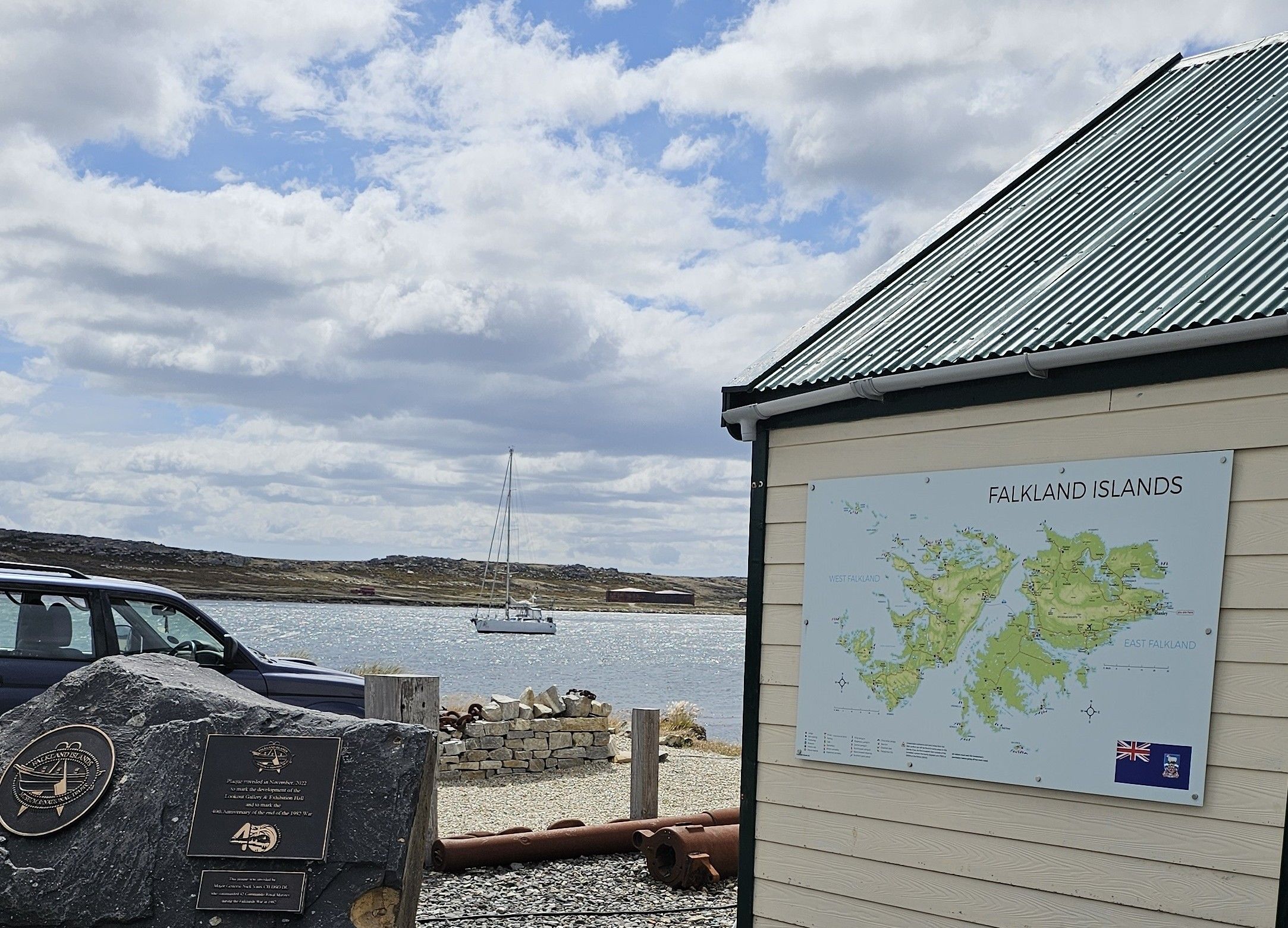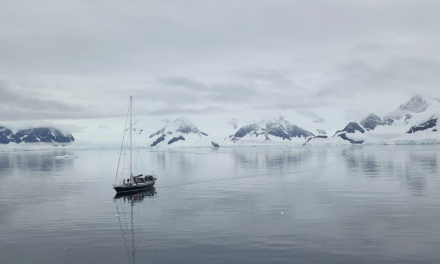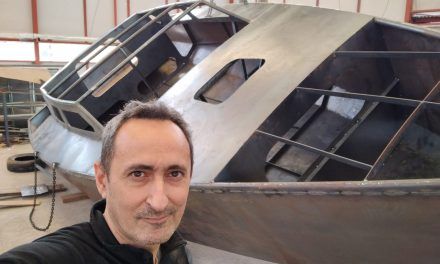Adventure books—novels, short stories, travel and sailing logs—were what captivated him as a child. It was unusual, at that time, when the first black-and-white televisions were blossoming like mushrooms in middle-class Argentine living rooms in the 1960s, for his parents to prefer other types of food for their children’s spirit and soul.
However, in his native Córdoba—a Mediterranean province in central Argentina, surrounded by sierras (small mountains), valleys, and stony streams, or even lime kilns—he became enthusiastic about the idea of owning a small-scale sailboat.
Sigfrido Nielsen says that the greatest impulse came in his adolescence: “Sailing, for me, will always be related to adventure, risk, and exploring new horizons.”
My parents had a very extensive library. There was no television in my house, but there were many books, and I had access to a vast amount of reading material: from Jules Verne and Emilio Salgari to Jack London and the entire Robin Hood series, to naval battles and the history of humanity itself, from Columbus to Magellan. Only from the heart of the Mediterranean, somewhat isolated city of Córdoba, reading took me to live in the world, from Alaska to the Philippines.”
Today, at 62 years old, aboard the Caoba—a 15-meter-long ship designed by Guy Rivadeau Dumas, prepared for ocean voyages, and entirely built in Mar del Plata—Sigfrido fulfilled a long-cherished dream: he crossed from Buenos Aires to the Falkland Islands, 1,290 kilometers of exceptional geography, with irregular coastlines and a multitude of natural harbors, which he circumnavigated for several weeks alongside two crew members and friends with certain peculiarities: one was a veteran of the armed conflict that broke out between Argentina and England in 1982 in the South Atlantic.
We thank Sigfrido for sharing his adventure with us in this fascinating interview.
Sigfrido, How did you get started in sailing?
My father, who is 91 years old, has a workshop in his house. When I was 13 or 14, he taught me how to work with fiberglass, and I built a sailboat out of it, inspired by the adventures I read about. It was a 1.20-meter boat, with its mast and keel. It sailed on Lake San Roque, and I swam behind it. I put the sails on, and the boat sailed. Then, when I was 17, I made a larger one, 1.70 meters long, remote-controlled. I ordered the sails from the Hood sailmaker. I read a lot about technical issues and got a sense of how they worked.
What happened next?
In my quest to build the first sailboats, I began reading sailing books and understanding the principles of sailing. A little later, I bought a racing book that talked about centerboard sailboats for two people, and I set off sailing for the first time on the Pamperos (a type of boat designed in Argentina). The first time I got on a sailboat was at the Los Molinos Dock: a friend of my father’s, whom we met by chance, invited us to sail. Within five minutes, I had already taken the helm and was steering the boat. The guy asked me if I had ever sailed before; I told him no, and he couldn’t believe it. But I think I knew a lot from everything I had read and from the sailboats they had designed to scale, where I knew what the compass rose, the beam, the stern, and the close-hauled sail meant.
Did you study anything related to all this?
No, I studied Geology at the National University of Córdoba, but it had a Physical Education department for students and graduates. A sailing team was formed, and I took the helmsman course. In my second year, I took a skipper course and sailed every weekend. We started with two Pamperos and soon there were more than 90 students. They took me on as an assistant because it was the largest Physical Education class at the faculty. The “The Sea Unites Us” program, run by the Argentine Navy, donated these sailboats and all the necessary equipment for sailing lessons to universities. A little later, we already had five Pamperos and a motorboat. Just two years later, I was also teaching the sailing yacht skipper course.
Then you arrived in Buenos Aires?
When I graduated, I traveled to Mendoza to complete my postgraduate studies and then came to work for YPF in Buenos Aires. For a time, I taught practical classes on the Río de la Plata on H19 sailboats. Over the years, I began to sail oceanically: I went to Ushuaia or Angra dos Reis, in Brazil, or we sailed up the entire Uruguay River. In 2020 (in the midst of the pandemic), we traveled to southern Argentina, with a total of fourteen stops, a lot of coastal sailing, and I traveled along the entire Argentine coastline. That’s why we later decided to consider the Falklands.
How was the Maoba prepared before setting sail? What elements did they have in place to anticipate the unexpected events inherent in ocean voyages?
I don’t work in an improvised way: there’s a whole team behind us, all of us friends, like a meteorologist or doctors who set up a first-aid kit and a first-aid room with a scalpel, equipment to open an IV, and injectable medication. They also provided equipment to fix joints in the case of trauma to arms or legs. I also communicated with amateur radio operators and a satellite phone. There’s a whole team on the ground following us and helping us.
Who were the crew members who accompanied you on this voyage?
I was accompanied by Alejandro Diego, who was a combatant in the war and was on board for two months in 1982, and Pablo Leoni, who had also sailed with me a few years ago across the South Atlantic.
What is navigation like in a region of high latitudes and strong winds? What precautions did you have to take in that regard?
The weather forecast is highly reliable; it’s not the same on the Río de la Plata as it is in the middle of the sea. The interaction between land and water sometimes means it has a lower degree of certainty. In the south, it’s easier, and the ten-day forecast is quite reliable. Once we leave, the meteorologist updates the forecast as the days go by. So, I’d leave a place and already know what I was going to find. But it works very well, and we’d put it into practice ever since we went touring the Patagonian coast.
How was the journey?
On December 8, 2024, we departed from Buenos Aires for Mar del Plata. From Mar del Plata, we departed on January 7, 2025, heading for Puerto Stanley (in Argentina, it’s called Puerto Argentino, the British call it Stanley), on the southern coast of Soledad Island, part of the Falkland Islands archipelago. We stopped in Caleta Hornos, north of the Gulf of San Jorge, in the Chubut Province, a very protected area near the port of Camarones, where we updated the weather forecast (with the Windy) after four days of sailing. This region is full of islands and coves; it’s the Southern Caribbean, and it’s beautiful. It’s a nature reserve, called Blue Patagonia, where there are seals, sea lions, and penguins in the sea, and foxes and guanacos on land. From Caleta Hornos, we arrived in Stanley in four days. The voyage took about ten days in total.
If you encountered bad weather, for example, how did you organize or what techniques did you use on board?
On our way to the Malvinas Islands, we stopped in that gulf near Camarones for a day or so because a very strong southerly front was approaching, with a headwind. We also stopped to rest because sailing was exhausting with three people on board. This lengthened the trip.
On the other hand, for the return trip, it was only six days, on a direct trip from Stanley to Mar del Plata, without stops, because it’s easier to travel south-north due to the low wind centers and the prevailing winds, which are from the south and southwest rather than the north wind. That journey was fantastic because it was 850 miles almost in a direct line: we just had to avoid the fishing fleet at mile marker 201 (which is an impressive, illuminated floating city of Chinese, Korean, and other boats, which fishes without control or limits 365 days a year). Many of those boats don’t have nighttime identification, and I’ve seen stories where they get aggressive or think you’re going to rat them out, so we preferred to avoid them and stuck to mile marker 180 on the mainland side, which is part of our Argentine territory. We arrived in Buenos Aires on February 18, 2025.
How did the inhabitants treat you?
I’m very grateful: they treated us very well. We were very calm; we didn’t want to provoke anything. The premise was to respect in order to be respected, to visit the significant sites of the war, and at the same time to seek to establish contact with local sailors and other residents. But when we arrived, we were on a public buoy near the coast, and a Falkland Islander came up (in a bad mood) to ask us to lower the Argentine flag. He was very aggressive, and we lowered the flag. They gave us a Falklands flag (we had already flown the British flag as a courtesy). But the authorities from the Coast Guard, Customs, and Immigration treated us very well and told us we had the right to fly the flag, which is international law, and they supported us in this.
But what did you perceive during your stay?
We stayed for several weeks, and after ten days in Stanley, we toured all the islands, also by boat. We never lowered the flag again. The people are friendly, and we never had any other problems. What we realized is that the inhabitants of the Falklands also suffered the war at home, because the villages were also packed with people, fighting in the fields a short distance from everything, and they were locked up or prisoners in their own homes. They don’t want to relive it, and it made them dislike us very much. What we seek with the trip is to contribute to reconciliation and heal wounds.
Ultimately, what do you think was the meaning of this trip?
We were the first sailboat to circumnavigate all the islands. We had many reasons for undertaking this voyage. However, I think one of the most important was to contribute to peace and to achieve, at some point, some kind of agreement between our countries. Ultimately, what we were looking for was to contribute our bit to that end and demonstrate that we can have good relations.
You can find more information about this project at the following links:
From “Navegantes Oceánicos” we thank Sigfrido Nielsen for sharing his adventure to the Malvinas Islands with our readers in this interesting interview, and we wish him the best of luck on his future voyages.














